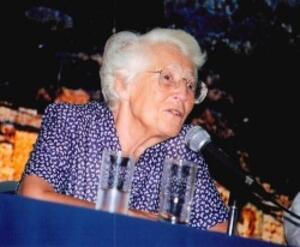Death of Hanna Segal, play therapy psychologist
Psychologist Hanna Segal speaks into a microphone.
Photo courtesy of Melanie Klein Trust.
In an interview with The Guardian in 1999, Dr. Hanna Segal described the foundation of her life’s interests. “I read Proust first, before Freud," she said. “And I think I simply realized that there was nothing, absolutely nothing, more fascinating than human nature. And human relations.”
Born into a cultured, well-to-do family in Lodz, in what is now Poland, on August 20, 1918, Segal studied psychiatry and literature in Warsaw in the late 1930s. She fled with them to London in 1940 to escape the growing Nazi takeover of Europe. There she completed her studies and became a patient and student of the psychologist Melanie Klein. During her years of study with Klein, Segal developed and interpreted her teacher’s concepts of children’s play as a kind of language that could help children express emotions they could not verbalize by using dolls and toys.
Segal’s 1964 book, Introduction to the Work of Melanie Klein, explained and made readable the often technically difficult psychoanalytic principles developed by Mrs. Klein from 1921 to 1960, the year of her death. Based on her theory of “object relations,” which Klein formulated in the 1920s, Kleinian play was designed to explore the infant-mother bond, which she considered the root of every person’s ability to form attachments in life—the “objects” in her notion of “object relations” referring mainly to people. It was Segal’s interpretation and explanation of Klein’s concepts that made play therapy universally accepted and practiced worldwide.
In Segal’s own psychology practice, she treated several artists who were blocked in their creative work. This enabled her to incorporate her interest in creativity, art and literature into her work, and led to the publication of “A Psychoanalytic Contribution to Aesthetics,” her now famous paper, perhaps the most original attempt at a psychoanalytical understanding of creativity. Segal’s lifelong endeavor was to explore the intricate relationship between creative and psychotic functioning.
Segal believed that the psychoanalytic understanding of the pervasiveness of our destructiveness and the human cost of its denial can contribute in an important way to sociopolitical issues. Her 1987 paper “Silence is the Real Crime” remains one of the most important psychoanalytic contributions to the nuclear debate.
The important thing in life, she insisted in her Guardian interview, is what Cormac McCarthy’s The Road taught her: to "keep a little fire burning; however small, however hidden. I find this extraordinarily helpful: we live in a mad world, but for those of us who believe in some human values, it is terribly important that we just keep this little fire burning. It is about trusting your judgment, and the power of love. A little trust, and a little care."
Her perception of the use of the destructive forces within us is perhaps best encapsulated in her own words:
“It is when the world within us is destroyed, when it is dead and loveless, when our loved ones are in fragments, and we ourselves in helpless despair—it is then that we must recreate our world anew, reassemble the pieces, infuse life into dead fragments, recreate life.”
Sources: “Melanie Klein,” Jewish Women: A Comprehensive Historical Encyclopedia; “Hanna Segal, Who Popularized Play Therapy, Dies at 92,” New York Times, August 2, 2011; “Hanna Segal Obituary,” The Guardian, July 14, 2011; “Queen of Darkness,” The Guardian, September 7, 2008; “Hanna Segal,” Melanie Klein Trust.



